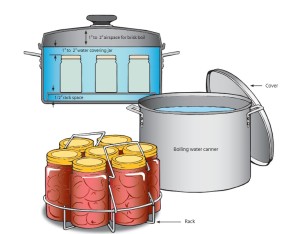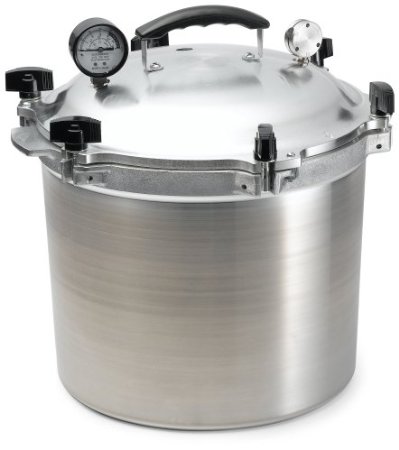This is Part 2 in my Simple Steps to Getting Started Canning series. (Click here for yesterday’s post, Part 1)
Today, I’ll go over the types of safe processing, food types for each, and the reasons certain types of foods require different types of processing.
As I said yesterday, one of the major concerns I hear when I talk about home canned goods is “Is it safe to eat?”. And the realistic answer is that, just like canned foods you buy in the store, it is only as safe as the precautions taken during the processing. If you follow the simple steps, you will not have any problems.
One of the first steps is knowing what kind of processing you need to do, based on the end product. There are two types of acknowledged, safe processing methods, water bath and pressure canning.
Boiling Water Bath Canning
Boiling water bath canning is the process of immersing hand-tighten jars that were sterilized, then filled with the appropriate product, and then kept at a rolling boil for the required amount of time.
 The hardware consists of a pot large enough and deep enough to place the jars to be processed inside with at least an inch of water over the top, and a rack of some sort on the bottom beneath the jars. You can buy a kit containing a pot complete with jar rack made just for Boiling Water Bath Canning, and it typically comes with the odds and ends that make canning easier, including jar lifters, jar funnel. However, any pot large enough will do, as long as you are sure to have the jars sitting above the bottom on some sort of raised rack, and still have enough space above the jars for an inch or more of water.
The hardware consists of a pot large enough and deep enough to place the jars to be processed inside with at least an inch of water over the top, and a rack of some sort on the bottom beneath the jars. You can buy a kit containing a pot complete with jar rack made just for Boiling Water Bath Canning, and it typically comes with the odds and ends that make canning easier, including jar lifters, jar funnel. However, any pot large enough will do, as long as you are sure to have the jars sitting above the bottom on some sort of raised rack, and still have enough space above the jars for an inch or more of water.
The Boiling Water Bath does two things. It drives most of the air out of the jar past the seal, causing the lid to stay in place due to a vacuum inside the jar. The other is to heat he contents to 212 degrees. The heat is enough to kill vegetative types of bacteria, but NOT Clostridium botulinum, known as botulism.
In order to kill Clostridium botulinum, you need a higher temperature (See below for Pressure Canning), or a pH of 4.6 or lower, called “high acid foods”. In the case of boiling water bath canning, only those items considered “high acid foods” can be safely processed.
These items include fruits, pickles, relishes, acidified tomatoes, fruit jellies, jams, butters, marmalades, and preserves. These are some of the simplest and most gratifying items to add to your pantry. And some of these are what we will be trying to to get you to make by the end of the week.
For items not considered “high acid foods”, you must use a pressure canner in order to properly destroy Clostridium botulinum.
Pressure Canning

Pressure canning require some special equipment in the form of a cooking pot and lid combo capable of sealing and maintaining 10-20 pounds of internal pressure. Much like Boiling Water Bath Canning, it does two important things. The first is that it allows the internal temperature of everything inside it reach at least 240 degrees Fahrenheit, plenty of heat to kill Clostridium botulinum. The second is that the internal pressure forces all of the air (more importantly, the oxygen) out of the jars, and just like in the Boiling Water Bath, it seals them under vacuum.
This process can be used to preserve a wide variety of foods, such as fruits, vegetables, meats (including red meats, poultry, and even fish)
Both processes result in a vacuum sealed jar that was heat treated. Lower heat treatment is all that is required for the high acid foods, and a higher heat treatment for the low acid foods. Both then yield a shelf stable product that can last for years.
I have found that, if given the choice, I prefer to water bath can simply because it takes less time, and cooks the food less. Pressure canning normally calls for 90 minutes or more of high pressure, high heat cooking. This tends to remove a lot of texture from foods, not a horrible thing, but something to keep in mind. Your fresh produce become a well cooked product once it is pressure canned.
That’s it for today. Yes there are other methods to preserve food that is labelled “canning”, but none are proven satisfactorily safe by any regulatory agency. Yes, I’ve read about folks using ovens to can beans and have never had a problem…but I won’t do it. I’ll stick to what is considered safe as far as food standards go.
Call me irrational.
Tomorrow, along the same thought pattern is sources for “safe” recipes. I will then follow up with sources for foods to preserve, and end with the process, start to finish for making Triple Berry Jam in your own kitchen, and then processing it for long term, shelf stable storage.
Peace,
db
As always, please “like” FloridaHillbilly on Facebook, subscribe to my feed, follow me on Twitter, add it to Google+, Pinterest, Linkdn, Digg, and/or tell your friends! The more folks that read this and learn how to can their own food, the fewer folks standing in grocery lines for wondering why the only thing left on the shelf was a can of Hearts of Palm after a disaster…
Need something from Amazon (and who doesn’t)? I earn a small commission from purchases made when you begin your Amazon shopping experience here. You still get great Amazon service and your price is the same, no matter what.
Somebody gets the referral fee, why not allow this old Hillbilly use it to help make ends meet?